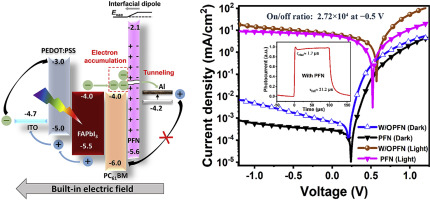Organic Electronics ( IF 3.2 ) Pub Date : 2020-03-28 , DOI: 10.1016/j.orgel.2020.105729 Quan Zhang , Meng Zhang , Fan Zhang , Xin Liu , Feng Teng , Yanbing Hou , Qiuhong Cui , Yufeng Hu , Zhidong Lou

|
Interfacial modification is an effective strategy to suppress the dark current in photodetectors for performance improvements. Here, solution-processed conjugated polymer electrolyte poly[(9,9-bis(3’-(N,N-dimethylamino)propyl)-2,7-fluorene)-alt-2,7-(9,9-dioctylfluorene)](PFN), widely used for interface engineering in organic and perovskite solar cells, is introduced to the photovoltaic photodetectors based on α-phase formamidinium lead iodide (α-FAPbI3) perovskite at cathode interfaces. The PFN layer has both positive and negative impacts on the overall device performances. The steady-state device parameters including external quantum efficiency, photoresponsivity, and detectivity are enhanced because the dark current is effectively suppressed due to the hindered hole injection by the PFN layer. However, the incorporation of PFN leads to different transient photocurrent dynamics with a peak after turn-on and a long-lived tail after turn-off, increasing the fall time, although it has little impact on the rise time. The proposed mechanisms involve the trapping and detrapping effects of accumulated photogenerated electrons at the electron-transporting layer/PFN interface, which are proved by capacitance-voltage measurements and impedance spectroscopy analysis. Our results have important significance for understanding the different effects and mechanisms of conjugated polymer electrolytes for interfacial engineering in photodetectors and solar cells and selecting suitable interfacial materials for electrode modification in photodetectors.
中文翻译:

了解共轭聚合物电解质在溶液处理有机-无机杂化钙钛矿光电探测器中进行界面改性的机理
界面修饰是抑制光电探测器中暗电流以提高性能的有效策略。在这里,溶液处理的共轭聚合物电解质聚[(9,9-双(3'-(N,N-二甲基氨基)丙基)-2,7-芴)-alt-2,7-(9,9-二辛基芴) ](PFN),广泛的有机和钙钛矿的太阳能电池,用于接口的工程,被引入到基于α相甲脒碘化铅(α-FAPbI光伏光电检测器3阴极界面处的钙钛矿。PFN层对整体设备性能具有正面和负面影响。包括外部量子效率,光响应性和检测性的稳态器件参数得到了增强,因为由于PFN层阻碍了空穴注入,暗电流得到了有效抑制。但是,掺入PFN会导致不同的瞬态光电流动态变化,尽管在上升时间上影响不大,但其导通后的峰值和关断后的长寿命尾部增加了下降时间。所提出的机制涉及电子传输层/ PFN界面处累积的光生电子的俘获和去俘获作用,这通过电容-电压测量和阻抗谱分析得到了证明。


























 京公网安备 11010802027423号
京公网安备 11010802027423号